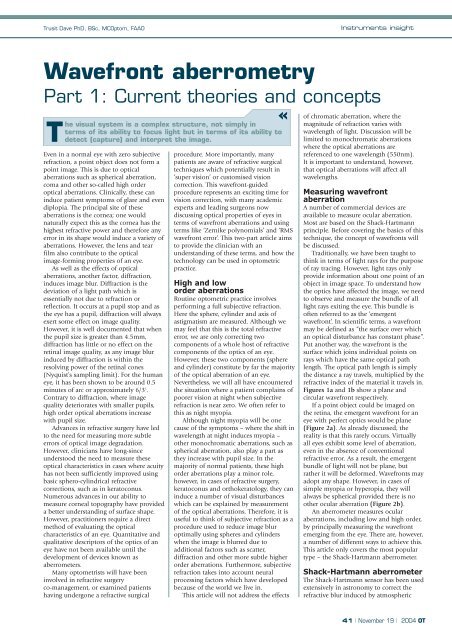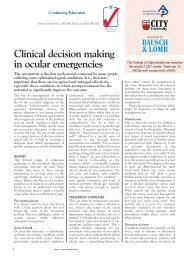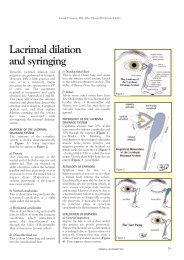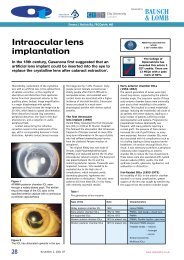Download the PDF
Download the PDF
Download the PDF
Create successful ePaper yourself
Turn your PDF publications into a flip-book with our unique Google optimized e-Paper software.
Trusit Dave PhD, BSc, MCOptom, FAAO<br />
Instruments insight<br />
Wavefront aberrometry<br />
Part 1: Current <strong>the</strong>ories and concepts<br />
T<br />
he<br />
visual system is a complex structure, not simply in<br />
terms of its ability to focus light but in terms of its ability to<br />
detect (capture) and interpret <strong>the</strong> image.<br />
Even in a normal eye with zero subjective<br />
refraction, a point object does not form a<br />
point image. This is due to optical<br />
aberrations such as spherical aberration,<br />
coma and o<strong>the</strong>r so-called high order<br />
optical aberrations. Clinically, <strong>the</strong>se can<br />
induce patient symptoms of glare and even<br />
diplopia. The principal site of <strong>the</strong>se<br />
aberrations is <strong>the</strong> cornea; one would<br />
naturally expect this as <strong>the</strong> cornea has <strong>the</strong><br />
highest refractive power and <strong>the</strong>refore any<br />
error in its shape would induce a variety of<br />
aberrations. However, <strong>the</strong> lens and tear<br />
film also contribute to <strong>the</strong> optical<br />
image-forming properties of an eye.<br />
As well as <strong>the</strong> effects of optical<br />
aberrations, ano<strong>the</strong>r factor, diffraction,<br />
induces image blur. Diffraction is <strong>the</strong><br />
deviation of a light path which is<br />
essentially not due to refraction or<br />
reflection. It occurs at a pupil stop and as<br />
<strong>the</strong> eye has a pupil, diffraction will always<br />
exert some effect on image quality.<br />
However, it is well documented that when<br />
<strong>the</strong> pupil size is greater than 4.5mm,<br />
diffraction has little or no effect on <strong>the</strong><br />
retinal image quality, as any image blur<br />
induced by diffraction is within <strong>the</strong><br />
resolving power of <strong>the</strong> retinal cones<br />
(Nyquist’s sampling limit). For <strong>the</strong> human<br />
eye, it has been shown to be around 0.5<br />
minutes of arc or approximately 6/3 1 .<br />
Contrary to diffraction, where image<br />
quality deteriorates with smaller pupils,<br />
high order optical aberrations increase<br />
with pupil size.<br />
Advances in refractive surgery have led<br />
to <strong>the</strong> need for measuring more subtle<br />
errors of optical image degradation.<br />
However, clinicians have long-since<br />
understood <strong>the</strong> need to measure <strong>the</strong>se<br />
optical characteristics in cases where acuity<br />
has not been sufficiently improved using<br />
basic sphero-cylindrical refractive<br />
corrections, such as in keratoconus.<br />
Numerous advances in our ability to<br />
measure corneal topography have provided<br />
a better understanding of surface shape.<br />
However, practitioners require a direct<br />
method of evaluating <strong>the</strong> optical<br />
characteristics of an eye. Quantitative and<br />
qualitative descriptors of <strong>the</strong> optics of an<br />
eye have not been available until <strong>the</strong><br />
development of devices known as<br />
aberrometers.<br />
Many optometrists will have been<br />
involved in refractive surgery<br />
co-management, or examined patients<br />
having undergone a refractive surgical<br />
procedure. More importantly, many<br />
patients are aware of refractive surgical<br />
techniques which potentially result in<br />
‘super vision’ or customised vision<br />
correction. This wavefront-guided<br />
procedure represents an exciting time for<br />
vision correction, with many academic<br />
experts and leading surgeons now<br />
discussing optical properties of eyes in<br />
terms of wavefront aberrations and using<br />
terms like ‘Zernike polynomials’ and ‘RMS<br />
wavefront error’. This two-part article aims<br />
to provide <strong>the</strong> clinician with an<br />
understanding of <strong>the</strong>se terms, and how <strong>the</strong><br />
technology can be used in optometric<br />
practice.<br />
High and low<br />
order aberrations<br />
Routine optometric practice involves<br />
performing a full subjective refraction.<br />
Here <strong>the</strong> sphere, cylinder and axis of<br />
astigmatism are measured. Although we<br />
may feel that this is <strong>the</strong> total refractive<br />
error, we are only correcting two<br />
components of a whole host of refractive<br />
components of <strong>the</strong> optics of an eye.<br />
However, <strong>the</strong>se two components (sphere<br />
and cylinder) constitute by far <strong>the</strong> majority<br />
of <strong>the</strong> optical aberration of an eye.<br />
Never<strong>the</strong>less, we will all have encountered<br />
<strong>the</strong> situation where a patient complains of<br />
poorer vision at night when subjective<br />
refraction is near zero. We often refer to<br />
this as night myopia.<br />
Although night myopia will be one<br />
cause of <strong>the</strong> symptoms – where <strong>the</strong> shift in<br />
wavelength at night induces myopia –<br />
o<strong>the</strong>r monochromatic aberrations, such as<br />
spherical aberration, also play a part as<br />
<strong>the</strong>y increase with pupil size. In <strong>the</strong><br />
majority of normal patients, <strong>the</strong>se high<br />
order aberrations play a minor role,<br />
however, in cases of refractive surgery,<br />
keratoconus and orthokeratology, <strong>the</strong>y can<br />
induce a number of visual disturbances<br />
which can be explained by measurement<br />
of <strong>the</strong> optical aberrations. Therefore, it is<br />
useful to think of subjective refraction as a<br />
procedure used to reduce image blur<br />
optimally using spheres and cylinders<br />
when <strong>the</strong> image is blurred due to<br />
additional factors such as scatter,<br />
diffraction and o<strong>the</strong>r more subtle higher<br />
order aberrations. Fur<strong>the</strong>rmore, subjective<br />
refraction takes into account neural<br />
processing factors which have developed<br />
because of <strong>the</strong> world we live in.<br />
This article will not address <strong>the</strong> effects<br />
of chromatic aberration, where <strong>the</strong><br />
magnitude of refraction varies with<br />
wavelength of light. Discussion will be<br />
limited to monochromatic aberrations<br />
where <strong>the</strong> optical aberrations are<br />
referenced to one wavelength (550nm).<br />
It is important to understand, however,<br />
that optical aberrations will affect all<br />
wavelengths.<br />
Measuring wavefront<br />
aberration<br />
A number of commercial devices are<br />
available to measure ocular aberration.<br />
Most are based on <strong>the</strong> Shack-Hartmann<br />
principle. Before covering <strong>the</strong> basics of this<br />
technique, <strong>the</strong> concept of wavefronts will<br />
be discussed.<br />
Traditionally, we have been taught to<br />
think in terms of light rays for <strong>the</strong> purpose<br />
of ray tracing. However, light rays only<br />
provide information about one point of an<br />
object in image space. To understand how<br />
<strong>the</strong> optics have affected <strong>the</strong> image, we need<br />
to observe and measure <strong>the</strong> bundle of all<br />
light rays exiting <strong>the</strong> eye. This bundle is<br />
often referred to as <strong>the</strong> ‘emergent<br />
wavefront’. In scientific terms, a wavefront<br />
may be defined as “<strong>the</strong> surface over which<br />
an optical disturbance has constant phase”.<br />
Put ano<strong>the</strong>r way, <strong>the</strong> wavefront is <strong>the</strong><br />
surface which joins individual points on<br />
rays which have <strong>the</strong> same optical path<br />
length. The optical path length is simply<br />
<strong>the</strong> distance a ray travels, multiplied by <strong>the</strong><br />
refractive index of <strong>the</strong> material it travels in.<br />
Figures 1a and 1b show a plane and<br />
circular wavefront respectively.<br />
If a point object could be imaged on<br />
<strong>the</strong> retina, <strong>the</strong> emergent wavefront for an<br />
eye with perfect optics would be plane<br />
(Figure 2a). As already discussed, <strong>the</strong><br />
reality is that this rarely occurs. Virtually<br />
all eyes exhibit some level of aberration,<br />
even in <strong>the</strong> absence of conventional<br />
refractive error. As a result, <strong>the</strong> emergent<br />
bundle of light will not be plane, but<br />
ra<strong>the</strong>r it will be deformed. Wavefronts may<br />
adopt any shape. However, in cases of<br />
simple myopia or hyperopia, <strong>the</strong>y will<br />
always be spherical provided <strong>the</strong>re is no<br />
o<strong>the</strong>r ocular aberration (Figure 2b).<br />
An aberrometer measures ocular<br />
aberrations, including low and high order,<br />
by principally measuring <strong>the</strong> wavefront<br />
emerging from <strong>the</strong> eye. There are, however,<br />
a number of different ways to achieve this.<br />
This article only covers <strong>the</strong> most popular<br />
type – <strong>the</strong> Shack-Hartmann aberrometer.<br />
Shack-Hartmann aberrometer<br />
The Shack-Hartmann sensor has been used<br />
extensively in astronomy to correct <strong>the</strong><br />
refractive blur induced by atmospheric<br />
41 | November 19 | 2004 OT
Instruments Insight<br />
Trusit Dave PhD, BSc, MCOptom, FAAO<br />
Figure 1a<br />
Parallel light rays travelling <strong>the</strong> same distance over time. The wavefront<br />
summarising <strong>the</strong> bundle of rays is plane<br />
Figure 1b<br />
Light rays travelling in different directions. The same distance is<br />
travelled over time (same phase), and <strong>the</strong> wavefront summarising<br />
<strong>the</strong> bundle is spherical<br />
Figure 2a<br />
The emergent wavefront of an eye with perfect optics, i.e. no refractive<br />
error and no high order aberrations<br />
Figure 2b<br />
The wavefront in an eye with simple myopia and no o<strong>the</strong>r aberrations.<br />
Here <strong>the</strong> emergent wavefront is perfectly spherical in shape<br />
turbulence. Astronomers developed an<br />
aberrometer to detect <strong>the</strong> aberrations<br />
induced by changes in atmospheric<br />
conditions and <strong>the</strong>n corrected <strong>the</strong>se using<br />
a deformable mirror – an optical<br />
engineering process known as adaptive<br />
optics 2 . This science is now being applied<br />
to <strong>the</strong> eye by virtue of an ocular<br />
aberrometer. The object of <strong>the</strong><br />
Shack-Hartmann aberrometer is to sample<br />
various points on <strong>the</strong> emerging wave<br />
and in doing so, derive <strong>the</strong> shape of <strong>the</strong><br />
Figure 3<br />
A diagrammatic representation of a<br />
Shack-Hartmann plate<br />
wavefront.<br />
Essentially, a Shack-Hartmann plate is a<br />
series of micro lenses arranged in a linear<br />
fashion (Figure 3). These lenslets are<br />
typically 0.25mm in diameter. Each lenslet<br />
focuses a view of <strong>the</strong> point source through<br />
various points of <strong>the</strong> entrance pupil<br />
(Figure 4). In this way, <strong>the</strong> aberrometer<br />
determines <strong>the</strong> shape of <strong>the</strong> wavefront<br />
exiting <strong>the</strong> eye. Although infrared light is<br />
used, <strong>the</strong> aberrations are measured with<br />
respect to peak spectral sensitivity of <strong>the</strong><br />
eye (550nm) by using a correction<br />
algorithm to account for <strong>the</strong> shift in focus<br />
from <strong>the</strong> measurement wavelength to <strong>the</strong><br />
reference wavelength 3 .<br />
Figure 5 shows <strong>the</strong> basic process<br />
involved in capturing <strong>the</strong> wavefront. For a<br />
perfect eye with no aberration, <strong>the</strong><br />
position of <strong>the</strong> spot on <strong>the</strong> CCD sensor<br />
will be at <strong>the</strong> optical axis of each lenslet.<br />
However, <strong>the</strong> reality is that in a normal<br />
eye, <strong>the</strong>re will be some level of aberration<br />
and, as such, <strong>the</strong> image of <strong>the</strong> spot will be<br />
Figure 4<br />
The principle of <strong>the</strong> Shack-Hartmann aberrometer<br />
42 | November 19 | 2004 OT
Instruments insight<br />
displaced from <strong>the</strong> optical axis. A question<br />
commonly asked is: “How is it that <strong>the</strong><br />
infrared laser forming a spot on <strong>the</strong> retina<br />
is not affected by <strong>the</strong> ocular aberrations?”<br />
The answer is that as <strong>the</strong> spot is very small<br />
and enters through <strong>the</strong> centre of <strong>the</strong><br />
entrance pupil to <strong>the</strong> fovea, <strong>the</strong> influence<br />
of <strong>the</strong> ocular aberrations is negligible.<br />
Thus, <strong>the</strong> CCD camera is used to<br />
capture <strong>the</strong> displacement of <strong>the</strong> spot from<br />
<strong>the</strong> optical axis of each lenslet.<br />
Displacements may occur in <strong>the</strong> horizontal<br />
and vertical meridian; Figure 6 shows <strong>the</strong><br />
displacement in <strong>the</strong> y meridian. The slope<br />
of <strong>the</strong> wavefront is easily calculated as <strong>the</strong><br />
displacement/<strong>the</strong> focal length of <strong>the</strong><br />
lenslet. After examining <strong>the</strong> slope at each<br />
micro lenslet in <strong>the</strong> x and y meridia, <strong>the</strong><br />
entire wavefront can be plotted in 3D.<br />
One of <strong>the</strong> objectives in measuring <strong>the</strong><br />
wavefront is to calculate <strong>the</strong> wavefront<br />
error (Figure 7). This describes <strong>the</strong> optical<br />
path difference between <strong>the</strong> measured<br />
wavefront and <strong>the</strong> reference wavefront<br />
(in microns) at <strong>the</strong> entrance pupil. The<br />
wavefront error is derived ma<strong>the</strong>matically<br />
from <strong>the</strong> reconstructed wavefront.<br />
However, <strong>the</strong>se computations result in<br />
many values of wavefront error. They are<br />
<strong>the</strong>refore plotted as a 2D or 3D wavefront<br />
error map for qualitative analysis (Figure<br />
7). These maps are analogous to colour<br />
coded corneal topography maps, where<br />
colours denote varying corneal dioptric<br />
power. In wavefront error maps, each<br />
colour represents a specific degree of<br />
wavefront error in microns. It is important<br />
to note <strong>the</strong> range and interval of <strong>the</strong> scale.<br />
Generally, in order to see as much detail as<br />
possible, choose <strong>the</strong> narrowest scale which<br />
permits <strong>the</strong> maximum number of colour<br />
changes within <strong>the</strong> map. However, when<br />
comparing pre and post treatments, make<br />
sure <strong>the</strong> same scale and step sizes are used<br />
to enable a like-for-like comparison. There<br />
is currently no absolute scale which has<br />
constant range and step size, as in corneal<br />
topography maps.<br />
Zernike polynomials<br />
The wavefront error map only provides<br />
qualitative information about <strong>the</strong><br />
wavefront. The shape of <strong>the</strong> wavefront<br />
takes on many forms and it is difficult for<br />
<strong>the</strong> clinician to evaluate <strong>the</strong> effects of <strong>the</strong><br />
shape on vision. In order to analyse <strong>the</strong><br />
wavefront quantitatively, it needs to be<br />
broken down into terms which are<br />
clinically meaningful. Conventional<br />
refraction breaks <strong>the</strong> wavefront down into<br />
only basic terms – sphere, cylinder and<br />
cylinder axis. A more sophisticated analysis<br />
is required to understand <strong>the</strong> subtle<br />
aberrations. Zernike polynomials are<br />
equations which are used to fit <strong>the</strong><br />
wavefront data in three dimensions. These<br />
polynomials have unique qualities, <strong>the</strong><br />
principal one being that <strong>the</strong>y decompose<br />
<strong>the</strong> shape of <strong>the</strong> wavefront into terms<br />
which describe optical aberrations such as<br />
spherical aberration, coma etc. Figure 8<br />
Figure 5<br />
The process involved in capturing <strong>the</strong> wavefront from <strong>the</strong> entrance pupil. Each lenslet captures a<br />
very small portion of <strong>the</strong> wavefront. The displacement of <strong>the</strong> spot is compared to that of a<br />
perfect wavefront. For a calibrated sensor, a perfect (or plane) wavefront would image <strong>the</strong> laser<br />
spot at <strong>the</strong> optical axis of <strong>the</strong> lenslet<br />
shows <strong>the</strong> Zernike modes commonly used<br />
to describe <strong>the</strong> measured wavefront.<br />
The individual modes, or terms, in <strong>the</strong><br />
polynomial have two variables, ρ (rho)<br />
and θ (<strong>the</strong>ta). ρ is <strong>the</strong> normalised distance<br />
from <strong>the</strong> pupil centre. Normalising ρ<br />
means it has a maximum value at <strong>the</strong> edge<br />
of <strong>the</strong> pupil of one. Therefore, for a 6mm<br />
pupil, a point 3mm from <strong>the</strong> centre would<br />
have a ρ value of 0.5. θ is <strong>the</strong> angular<br />
subtense of <strong>the</strong> imaginary line joining <strong>the</strong><br />
pupil centre and <strong>the</strong> point of interest to<br />
<strong>the</strong> horizontal (Figure 9).<br />
The key point here is that aberrations<br />
are dependent on pupil size. Therefore, all<br />
aberrometry measures must be related to<br />
<strong>the</strong> patient’s pupil diameter. Wavefront<br />
measures must be referenced to a pupil<br />
size.<br />
Each term is sequentially added to<br />
describe <strong>the</strong> entire wavefront. Thus, <strong>the</strong><br />
wavefront may be described as:<br />
W(ρ,θ)=C 1<br />
-1<br />
Z 1<br />
-1<br />
+C 11<br />
Z 11<br />
+C 2<br />
-2<br />
Z 2<br />
-2<br />
+C 20<br />
Z 20<br />
+C 22<br />
Z 2<br />
2<br />
+C 3<br />
-3<br />
Z 3<br />
-3<br />
+C 3<br />
-1<br />
Z 3<br />
-1<br />
+C 31<br />
Z 31<br />
+C 33<br />
Z 33<br />
+C 4<br />
-2<br />
Z 4<br />
-2<br />
etc<br />
Zernike terms are defined using a double<br />
index notation as proposed by <strong>the</strong> Optical<br />
Figure 6<br />
Calculation of <strong>the</strong> slope of <strong>the</strong> wavefront from <strong>the</strong><br />
displacement of <strong>the</strong> image at each individual lenslet<br />
43 | November 19 | 2004 OT
Instruments Insight<br />
Trusit Dave PhD, BSc, MCOptom, FAAO<br />
Figure 7<br />
The wavefront error map shows <strong>the</strong> difference between <strong>the</strong><br />
aberrated and reference (plane) wavefront. Once this information is<br />
processed for all points over <strong>the</strong> pupil, a 2D wavefront error map<br />
can be displayed (right) Figure 8<br />
Society of America 4 . This nomenclature<br />
groups each term according to <strong>the</strong> radial<br />
order (n) and angular frequency (m), thus<br />
each term is written in <strong>the</strong> form Z m n. The<br />
radial order (n) groups Zernike modes in<br />
terms ρ (rho), whereas <strong>the</strong> angular<br />
frequency (m) groups <strong>the</strong> modes in terms<br />
of θ (<strong>the</strong>ta). The coefficient, C, in each<br />
term varies according to <strong>the</strong> number of<br />
modes in <strong>the</strong> Zernike polynomial. C<br />
defines <strong>the</strong> level of a particular mode of<br />
aberration in microns and can have a<br />
positive or negative value.<br />
A list of <strong>the</strong> Zernike terms and <strong>the</strong>ir<br />
optical equivalent up to <strong>the</strong> fourth order is<br />
shown in Table 1. There are, in fact, an<br />
infinite number of Zernike terms which<br />
can be used to fit an individual wavefront.<br />
In practice, however, Zernike terms up to<br />
<strong>the</strong> 4th radial order are measured.<br />
It is worth understanding <strong>the</strong> actual<br />
terms in <strong>the</strong> equation. Let us take <strong>the</strong><br />
example of secondary astigmatism or Z 2 4.<br />
−1<br />
Z1 = 4ρ<br />
sin( θ )<br />
1<br />
Z1 = 4ρ<br />
cos( θ )<br />
−<br />
Z<br />
2 6 2<br />
2<br />
= ρ sin(2θ<br />
)<br />
0<br />
2<br />
Z2 = 3(2ρ<br />
−1)<br />
Z<br />
2 = 6ρ<br />
2 cos(2 θ )<br />
2<br />
Individual modes of Zernike polynomials up to fourth order. ‘n’<br />
represents <strong>the</strong> radial order and ‘m’ <strong>the</strong> angular frequency<br />
Table 1<br />
The double index notation of Zernike term, <strong>the</strong> equation of each mode in <strong>the</strong> Zernike polynomial<br />
and <strong>the</strong> appearance of each mode in a colour-coded wavefront error map<br />
Zernike term WFE Map Optical equivalent<br />
Vertical prism<br />
Horizontal prism<br />
Astigmatism<br />
Defocus<br />
Astigmatism<br />
The Zernike equation is<br />
Z 2 4 = √10(4ρ 4 −3ρ 2 )cos(2θ)<br />
What does<br />
this mean?<br />
As you can see, <strong>the</strong>re are only two<br />
variables in all <strong>the</strong> modes in Table 1.<br />
Broadly speaking, you can categorise each<br />
equation into three areas.<br />
Figure 9<br />
Wavefront error map defining ρ and θ<br />
−<br />
Z<br />
3 8 3<br />
3<br />
= ρ sin(3θ<br />
)<br />
−1<br />
3<br />
Z3 = 8(3ρ<br />
− 2ρ)sin(<br />
θ )<br />
1<br />
3<br />
Z3 = 8(3ρ − 2ρ)<br />
cos( θ )<br />
Z<br />
3 = 8ρ<br />
3 cos(3 θ )<br />
3<br />
−<br />
Z<br />
4 10 4<br />
4<br />
= ρ sin(4θ<br />
)<br />
−2<br />
4 2<br />
Z4 = 10(4ρ<br />
−3ρ<br />
) sin(2θ<br />
)<br />
0<br />
4 2<br />
Z4 = 5(6ρ<br />
− 6ρ<br />
+ 1)<br />
2<br />
4 2<br />
Z4 = 10(4ρ<br />
− 3ρ<br />
)cos(2θ<br />
)<br />
Z<br />
4 = 10ρ<br />
4 cos(4 θ )<br />
4<br />
Trefoil<br />
Coma<br />
Coma<br />
Trefoil<br />
Tetrafoil<br />
Secondary astigmatism<br />
Spherical aberration<br />
Secondary astigmatism<br />
Tetrafoil<br />
44 | November 19 | 2004 OT
Instruments insight<br />
Z 2 4 = √10(4ρ 4 −3ρ 2) cos(2θ)<br />
Normalisation<br />
term<br />
Radial<br />
term<br />
Angular<br />
term<br />
Normalisation of each mode means that<br />
observation of <strong>the</strong> coefficients<br />
immediately gives an indication of <strong>the</strong><br />
level of influence each type of aberration<br />
has on <strong>the</strong> total aberration 5 . The radial<br />
term, in this case of <strong>the</strong> fourth order,<br />
describes <strong>the</strong> variation of <strong>the</strong> wavefront<br />
error with distance from pupil centre. The<br />
largest power ρ is raised to is <strong>the</strong> radial<br />
order, i.e. to <strong>the</strong> power 4. The angular<br />
frequency describes <strong>the</strong> number of repeat<br />
cycles which are made over 360 degrees.<br />
For example, in secondary astigmatism,<br />
<strong>the</strong>re are two repeat cycles over <strong>the</strong><br />
circular pupil, thus <strong>the</strong> radial order is 2.<br />
Also, notice that where <strong>the</strong> radial order is<br />
assigned a negative value, <strong>the</strong> equation<br />
uses <strong>the</strong> sine of θ to describe <strong>the</strong> angular<br />
variation.<br />
The first order term, prism, is not<br />
relevant to <strong>the</strong> wavefront as <strong>the</strong>y represent<br />
tilt and are corrected using a prism. The<br />
second order terms represent low order<br />
aberrations, namely defocus and<br />
astigmatism. Defocus represents <strong>the</strong><br />
spherical component of <strong>the</strong> wavefront.<br />
The astigmatic terms conversely describe<br />
<strong>the</strong> cylinder. Using <strong>the</strong>se three terms, any<br />
sphero-cylindrical lens can be described.<br />
Wavefront maps with defocus and<br />
astigmatism only can be perfectly<br />
corrected using spectacles and contact<br />
lenses. Caution, however, needs to be<br />
exercised when interpreting <strong>the</strong>se terms as<br />
in practice, patient wavefront error maps<br />
have high order terms. As a result, defocus<br />
and astigmatism terms do not represent<br />
<strong>the</strong> sphere and cylinder terms found in<br />
subjective refraction. An estimate of<br />
subjective refraction can be made if only<br />
<strong>the</strong>se three terms are fit to <strong>the</strong> wavefront<br />
data. Second order terms are referred to as<br />
low order aberrations.<br />
Every mode after second order is a high<br />
order aberration. These terms cannot be<br />
measured in conventional refraction or<br />
autorefraction. The only method of<br />
quantifying <strong>the</strong>se terms is by using an<br />
aberrometer. The third order terms<br />
describe coma and trefoil astigmatism.<br />
These terms cannot be corrected using<br />
spectacles, soft or RGP contact lenses.<br />
Attempts have been made to correct<br />
spherical aberration in contact lenses<br />
using aspheric designs. However, this<br />
correction only corrects for lens specific<br />
spherical aberration and not <strong>the</strong> combined<br />
effect of eye and lens. Therefore, <strong>the</strong><br />
optical benefits of such a design may<br />
improve image quality for some patients<br />
but equally <strong>the</strong>re may be some<br />
deterioration in image quality in o<strong>the</strong>r<br />
patients 6 .<br />
Root mean square error<br />
In order to summarise <strong>the</strong> wavefront error,<br />
scientists have tried to develop metrics to<br />
try and best describe <strong>the</strong> wavefront error as<br />
a numeric index. At <strong>the</strong> present time, <strong>the</strong><br />
most widely used metric is <strong>the</strong> root mean<br />
square (RMS) error. All aberrometers<br />
display a RMS error of high and low order<br />
aberrations. This term describes <strong>the</strong><br />
weighted mean of <strong>the</strong> individual Zernike<br />
modes. In o<strong>the</strong>r words, <strong>the</strong> RMS value<br />
describes <strong>the</strong> overall aberration and gives a<br />
‘feel’ of how bad an individual’s<br />
aberrations are. The RMS error is simply:<br />
RMS=√(C2 -2 ) 2 +(C 0 2) 2 +(C 2 2) 2 +(C -3 3) 2 +(C -1 3) 2 ...etc<br />
There are number of disadvantages in<br />
using <strong>the</strong> RMS value. The most significant<br />
is that increases in RMS value do not<br />
necessarily result in decreases in image<br />
quality 5 . For example, if a subject has some<br />
defocus and spherical aberration, <strong>the</strong>n it is<br />
possible that <strong>the</strong> spherical aberration will<br />
help reduce some of <strong>the</strong> image blur<br />
induced on <strong>the</strong> retina. However, because<br />
of <strong>the</strong> way RMS is calculated, <strong>the</strong><br />
cancelling effects of one aberration over<br />
ano<strong>the</strong>r are not considered 7 . As research<br />
continues, better predictors of visual<br />
function will develop 5,8 .<br />
Studies have evaluated normative<br />
values of ocular aberration. Porter et al 9<br />
found a random variation in <strong>the</strong> wavefront<br />
aberration of 109 normal subjects with an<br />
artificial pupil diameter of 5.7mm. Chalita<br />
et al 10 performed aberrometry in 60 eyes<br />
and found mean values of 0.35±0.29<br />
microns for coma; 0.36±0.31 for spherical<br />
aberration; and 0.31±0.14 microns for<br />
o<strong>the</strong>r high order terms for a pupil<br />
diameter of 7mm. It has also been<br />
documented that 91% of <strong>the</strong> RMS<br />
wavefront error can be accounted for by<br />
<strong>the</strong> second order and 99% if Zernike<br />
terms from <strong>the</strong> first four orders are used to<br />
fit <strong>the</strong> wavefront for a pupil diameter of<br />
5mm 11 . Wang and Koch 12 measured ocular<br />
aberrations in subjects screened for<br />
refractive surgery. High order aberrations<br />
were found to have a mean RMS of<br />
0.305±0.095 in 532 eyes across a 6mm<br />
pupil. Spherical aberration was found to<br />
be 0.128±0.074 and coma 0.170±0.089<br />
microns.<br />
Any instrument involved in clinical<br />
measurement must be both accurate and<br />
repeatable. Cheng et al 13 measured <strong>the</strong><br />
accuracy and repeatability of <strong>the</strong> COAS<br />
(Wavefront Sciences) Shack-Hartmann<br />
aberrometer on model eyes. They found<br />
<strong>the</strong> instrument to be both accurate and<br />
repeatable on model eyes. In ano<strong>the</strong>r<br />
study, Cheng et al 14 evaluated <strong>the</strong> variation<br />
of monochromatic aberrometry<br />
measurements over a range of timescales<br />
(five measures in one second without<br />
realignment, five measures in one hour<br />
with realignment at <strong>the</strong> same time over<br />
five days and on five days at monthly<br />
intervals). The authors concluded that<br />
variations in aberrometry maps between<br />
days and months was due to biological<br />
changes to <strong>the</strong> eye, and that this<br />
fluctuation would prevent practitioners<br />
from achieving perfect optical correction,<br />
i.e. an aberration-free eye. Wavefront maps<br />
are also known to vary with<br />
accommodation 15 , tear film quality 16 and<br />
media opacities 17 .<br />
Part 2 of this article, to be<br />
published on December 3, will look<br />
at applications of wavefront<br />
aberrometry in clinical practice.<br />
About <strong>the</strong> author<br />
Dr Trusit Dave is Director of Optimed<br />
(Ophthalmic Medical Instruments),<br />
Clinical Consultant for Topcon GB and a<br />
partner in private practice in Coventry.<br />
References<br />
For a full set of references, email<br />
nicky@optometry.co.uk.<br />
Continuing Education and Training<br />
Systemic Pathology<br />
Orderline: 01252-810939 Fax: 01252-816176<br />
NEW<br />
This book on ‘Systemic Pathology’ is designed to give practitioners and optometric students a<br />
better understanding of <strong>the</strong> principles and practice of clinical medicine and surgery, and in<br />
particular, of <strong>the</strong> fur<strong>the</strong>r management of patients referred by optometrists.<br />
£39.50<br />
45 | November 19 | 2004 OT
















